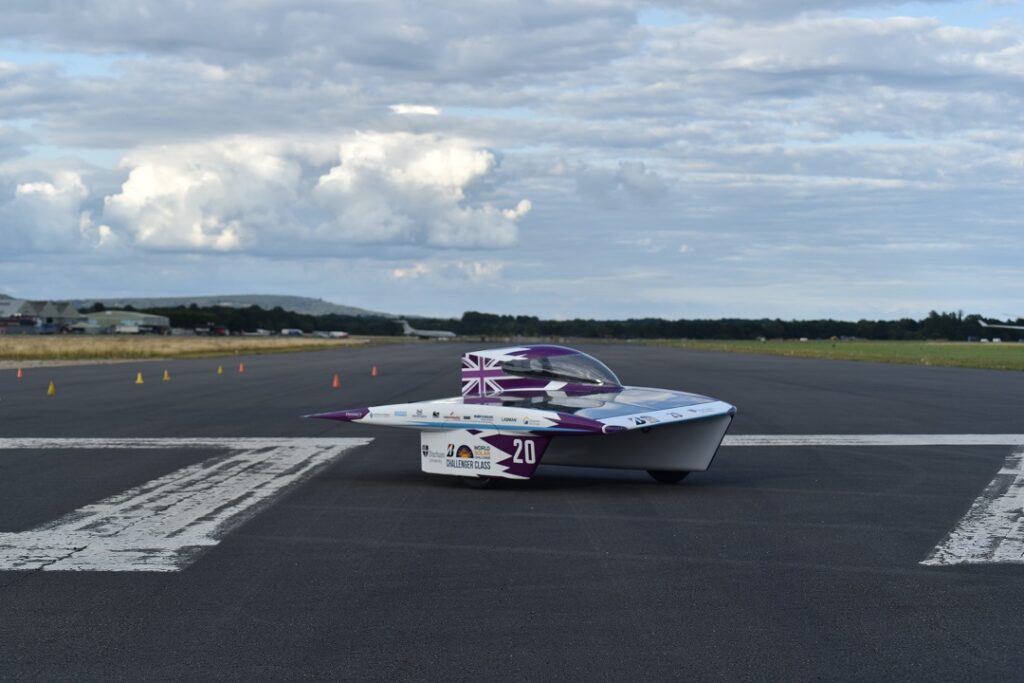Durham University Solar Car is a student led society that operates out of the Department of Engineering, consisting of 50 members from a range of subjects. We design and manufacture cutting edge solar powered cars from scratch, entering events across the globe. We are passionate about developing sustainable electric vehicle transport by pushing available technology to its limit to realise future transport solutions. This year’s car has been designed from the ground up to compete in The Bridgestone World Solar Challenge, a 3022km event across central Australia in under six days with power only from the sun. We will compete with over 40 teams from 24 countries in a week-long adventure across the barren outback, all aiming to be the first team to cross the finish line first in Adelaide.
Building a solar car
Although the team flies out to Australia at the start of October, the design and manufacture of this car started nearly two years ago, becoming a mammoth effort for our team to get the car campaign ready. This involved months manufacturing huge molds for us to create the fully carbon fiber body, weeks of soldering complex electronics and countless hours installing components into the car. Having spent all of last year (2022-23) building the car in our free time whether that be after lectures, at the weekend or late into the night; we were finally rewarded with a running car by July. This achievement is truly a credit to the dedication of every member of the team, the support from the Department of Engineering and our amazing sponsors.

As with any car the next step after manufacture is testing. After a handful of car park tests and a successful launch event; we packed up and headed down the country to Dunsfold park, better known as the Top Gear test track! After a grueling nine hour drive down from Durham in the dark, we woke early the next day eager to see what our car could do. We couldn’t wait to see what months of hard work looked like going around a track at full speed, we were not disappointed.
Testing a solar car
The few days we have to test our car is one of the most important parts of a build cycle, it allows us to do a number of things:
- Train drivers on how to operate the car
- Practice safety protocols to keep everyone safe in and around the car
- Collect data
- But most importantly, to check the car works!
Day one started with the first point, getting two freshers into the car to learn what driving a solar car is about; an amazing experience for two students who a year previously had no knowledge of the team. From there the car got moving and seemingly never stopped. We covered hundreds of kilometers learning and collecting data as we went, only stopping to tune the car and give the drivers some quick lunch! After a full day of running in the sun we retreated to a Pizza Express for a well-earned rest.

Day two was much of the same, collecting data we could use in our event strategy for Australia, covering more kilometers and trying not to get burnt by the UK summer sun. We had a great time receiving a visit from one of our sponsors, Serica Energy, who had been instrumental in helping us get to this point. After two long and successful days testing we packed up and headed back up to Durham.

Shipping a solar car
So what’s next? With little time left, the team worked tirelessly to get the car ready and packed up for it to be loaded onto a ship bound for Darwin, Australia. Finally, the day came to pack the car and everything we would need for Australia into a 20ft shipping container and onto a ship from Southampton.
Although the car is now on its way to Australia this is just the start of our journey this year, with the event only a month away there is still lots to do. To follow our story or get involved with the team this coming year.

The car
A technical fact file of our car:
- Top speed in excess of 70mph
- Full carbon fiber construction for its strength to weight ratio
- A single in-wheel electric motor behind the driver
- 4m squared solar panels array to power the car through the outback
- A 5kWh battery back which alone gives the car a range of over 250 miles or 400km
- Produces the same drag as a conventional wing mirror
Discover more
Follow us on our social media channels
Website: https://dusolarcar.org/
Instagram: @du_solarcar
LinkedIn: @du-solarcar

Oliver Holme
I am a first-year undergraduate engineering student that is part of Durham University Solar Car team. I have spent last year building the car our team is going to take to Australia. This year I will be acting as the team's treasurer which I am super excited for.








